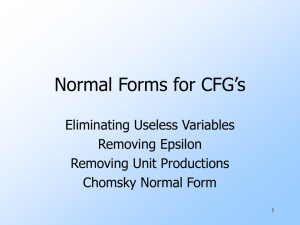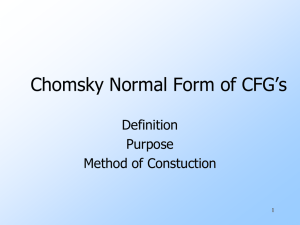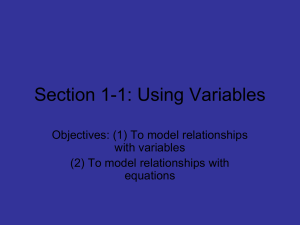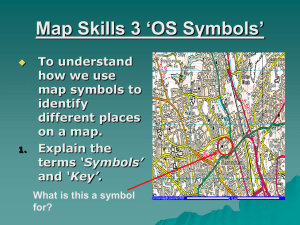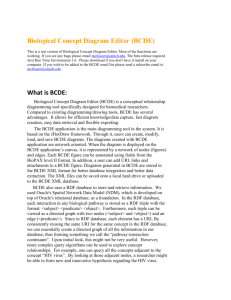CNF-CKY
advertisement
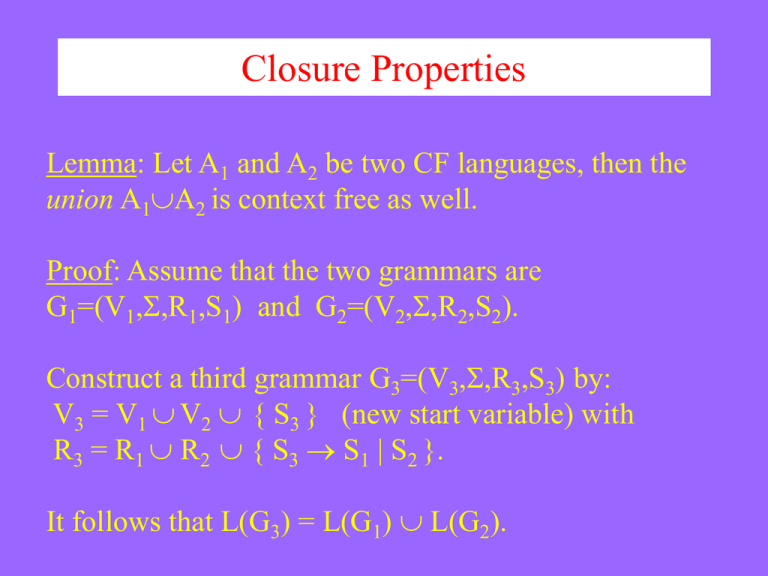
Closure Properties
Lemma: Let A1 and A2 be two CF languages, then the
union A1A2 is context free as well.
Proof: Assume that the two grammars are
G1=(V1,,R1,S1) and G2=(V2,,R2,S2).
Construct a third grammar G3=(V3,,R3,S3) by:
V3 = V1 V2 { S3 } (new start variable) with
R3 = R1 R2 { S3 S1 | S2 }.
It follows that L(G3) = L(G1) L(G2).
Intersection, Complement?
Let again A1 and A2 be two CF languages.
One can prove that, in general,
the intersection A1 A2 ,
and
the complement Ā1= * \ A1
are not context free languages.
Intersection, Complement?
Proof for complement:
The language
L = { x#y | x, y are in {a, b}*, x != y} IS context-free.
Complement of this language is
L’ = { w | w has no # symbol} U
{ w | w has two or more # symbols} U
{ w#w | w is in {a,b}* }.
We can show that L’ is NOT context-free.
Context-free languages are NOT closed under
intersection
Proof by counterexample: Recall that in an earlier slide in
this lecture, we showed that
L = {anbncn | n >= 0} is NOT context-free.
Let
A = {anbncm | n, m >= 0} and
B = L = {anbmcm | n, m >= 0}. It is easy to see that both A
and B are context-free. (Design CFG’s.)
This shows that CFG’s are not closed under intersection.
Intersection with regular languages
If L is a CFL and R is a regular language, then L R is
context-free.
Proof of Theorem 7.27
Proof of Theorem 7.27
Normal Forms for CFG’s
Eliminating Useless Variables
Removing Epsilon
Removing Unit Productions
Chomsky Normal Form
8
Variables That Derive Nothing
Consider: S -> AB, A -> aA | a, B -> AB
Although A derives all strings of a’s, B
derives no terminal strings (can you prove
this fact?).
Thus, S derives nothing, and the language is
empty.
9
Testing Whether a Variable Derives Some
Terminal String
• Basis: If there is a production A -> w, where w
has no variables, then A derives a terminal
string.
• Induction: If there is a production
A -> ,
where consists only of terminals and
variables known to derive a terminal string,
then A derives a terminal string.
10
Testing – (2)
• Eventually, we can find no more variables.
• An easy induction on the order in which
variables are discovered shows that each
one truly derives a terminal string.
• Conversely, any variable that derives a
terminal string will be discovered by this
algorithm.
11
Proof of Converse
• The proof is an induction on the height of
the least-height parse tree by which a
variable A derives a terminal string.
• Basis: Height = 1. Tree looks like:
A
• Then the basis of the algorithm
tells us that A will be discovered.
a1 . . . an
12
Induction for Converse
• Assume IH for parse trees of height < h, and
suppose A derives a terminal string via a A
parse tree of height h:
X1 . . . Xn
• By IH, those Xi’s that are
variables are discovered.
w1
wn
• Thus, A will also be discovered, because it
has a right side of terminals and/or
discovered variables.
13
Algorithm to Eliminate Variables That Derive
Nothing
1. Discover all variables that derive terminal
strings.
2. For all other variables, remove all
productions in which they appear either on
the left or the right.
14
Example: Eliminate Variables
S -> AB | C, A -> aA | a, B -> bB, C -> c
• Basis: A and C are identified because of A ->
a and C -> c.
• Induction: S is identified because of S -> C.
• Nothing else can be identified.
• Result: S -> C, A -> aA | a, C -> c
15
Unreachable Symbols
• Another way a terminal or variable deserves to
be eliminated is if it cannot appear in any
derivation from the start symbol.
• Basis: We can reach S (the start symbol).
• Induction: if we can reach A, and there is a
production A -> , then we can reach all
symbols of .
16
Unreachable Symbols – (2)
• Easy inductions in both directions show that
when we can discover no more symbols, then
we have all and only the symbols that appear
in derivations from S.
• Algorithm: Remove from the grammar all
symbols not discovered reachable from S and
all productions that involve these symbols.
17
Eliminating Useless Symbols
•
•
A symbol is useful if it appears in some
derivation of some terminal string from
the start symbol.
Otherwise, it is useless.
Eliminate all useless symbols by:
1. Eliminate symbols that derive no terminal
string.
2. Eliminate unreachable symbols.
18
Example: Useless Symbols – (2)
S -> AB, A -> C, C -> c, B -> bB
• If we eliminated unreachable symbols first,
we would find everything is reachable.
• A, C, and c would never get eliminated.
19
Why It Works
• After step (1), every symbol remaining
derives some terminal string.
• After step (2) the only symbols remaining
are all derivable from S.
• In addition, they still derive a terminal
string, because such a derivation can only
involve symbols reachable from S.
20
Epsilon Productions
• We can almost avoid using productions of the
form A -> ε (called ε-productions ).
– The problem is that ε cannot be in the language of
any grammar that has no ε–productions.
• Theorem: If L is a CFL, then L-{ε} has a CFG
with no ε-productions.
21
Nullable Symbols
• To eliminate ε-productions, we first need to
discover the nullable variables = variables
A such that A =>* ε.
• Basis: If there is a production A -> ε, then
A is nullable.
• Induction: If there is a production
A ->
, and all symbols of are nullable, then A
is nullable.
22
Example: Nullable Symbols
S -> AB, A -> aA | ε, B -> bB | A
• Basis: A is nullable because of A -> ε.
• Induction: B is nullable because of B ->
A.
• Then, S is nullable because of S -> AB.
23
Eliminating ε-Productions
• Key idea: turn each production
A ->
X1…Xn into a family of productions.
• For each subset of nullable X’s, there is one
production with those eliminated from the
right side “in advance.”
– Except, if all X’s are nullable, do not make a
production with ε as the right side.
24
Example: Eliminating ε-Productions
S -> ABC, A -> aA | ε, B -> bB | ε, C -> ε
• A, B, C, and S are all nullable.
• New grammar:
S -> ABC | AB | AC | BC | A | B | C
A -> aA | a
B -> bB | b
Note: C is now useless.
Eliminate its productions.
Why it Works
•
Prove that for all variables A:
1. If w ε and A =>*old w, then A =>*new w.
2. If A =>*new w then w ε and A =>*old w.
•
Then, letting A be the start symbol proves
that L(new) = L(old) – {ε}.
•
(1) is an induction on the number of steps by
which A derives w in the old grammar.
26
Proof of 1 – Basis
• If the old derivation is one step, then A ->
w must be a production.
• Since w ε, this production also appears in
the new grammar.
• Thus, A =>new w.
27
Proof of 1 – Induction
• Let A =>*old w be an n-step derivation, and
assume the IH for derivations of less than n
steps.
• Let the first step be A =>old X1…Xn.
• Then w can be broken into w = w1…wn,
• where Xi =>*old wi, for all i, in fewer than n
steps.
28
Induction – Continued
• By the IH, if wi ε, then Xi =>*new wi.
• Also, the new grammar has a production
with A on the left, and just those Xi’s on the
right such that wi ε.
– Note: they all can’t be ε, because w ε.
• Follow a use of this production by the
derivations Xi =>*new wi to show that A
derives w in the new grammar.
29
Proof of Converse
• We also need to show part (2) – if w is
derived from A in the new grammar, then it
is also derived in the old.
• Induction on number of steps in the
derivation.
• We’ll leave the proof for reading in the text.
30
Unit Productions
• A unit production is one whose right side
consists of exactly one variable.
• These productions can be eliminated.
• Key idea: If A =>* B by a series of unit
productions, and B -> is a non-unitproduction, then add production A -> .
• Then, drop all unit productions.
31
Unit Productions – (2)
• Find all pairs (A, B) such that A =>* B by a
sequence of unit productions only.
• Basis: Surely (A, A).
• Induction: If we have found (A, B), and B > C is a unit production, then add (A, C).
32
Cleaning Up a Grammar
•
Theorem: if L is a CFL, then there is a
CFG for L – {ε} that has:
1. No useless symbols.
2. No ε-productions.
3. No unit productions.
•
I.e., every right side is either a single
terminal or has length > 2.
33
Cleaning Up – (2)
•
•
Proof: Start with a CFG for L.
Perform the following steps in order:
1. Eliminate ε-productions.
2. Eliminate unit productions.
3. Eliminate variables that derive no terminal
string.
4. Eliminate variables not reached from the start
symbol.
Must be first. Can create
unit productions or useless
variables.34
Chomsky Normal Form
•
A CFG is said to be in Chomsky Normal
Form if every production is of one of
these two forms:
1. A -> BC (right side is two variables).
2. A -> a (right side is a single terminal).
•
Theorem: If L is a CFL, then L – {ε} has
a CFG in CNF.
35
Proof of CNF Theorem
• Step 1: “Clean” the grammar, so every
production right side is either a single terminal
or of length at least 2.
• Step 2: For each right side a single terminal,
make the right side all variables.
– For each terminal a create new variable Aa and
production Aa -> a.
– Replace a by Aa in right sides of length > 2.
36
Example: Step 2
• Consider production A -> BcDe.
• We need variables Ac and Ae. with
productions Ac -> c and Ae -> e.
– Note: you create at most one variable for each
terminal, and use it everywhere it is needed.
• Replace A -> BcDe by A -> BAcDAe.
37
CNF Proof – Continued
• Step 3: Break right sides longer than 2 into
a chain of productions with right sides of
two variables.
• Example: A -> BCDE is replaced by A ->
BF, F -> CG, and G -> DE.
– F and G must be used nowhere else.
38
Example of Step 3 – Continued
• Recall A -> BCDE is replaced by
A ->
BF, F -> CG, and G -> DE.
• In the new grammar, A => BF => BCG =>
BCDE.
• More importantly: Once we choose to
replace A by BF, we must continue to BCG
and BCDE.
– Because F and G have only one production.
39
CNF Proof – Concluded
• We must prove that Steps 2 and 3 produce
new grammars whose languages are the
same as the previous grammar.
• Proofs are of a familiar type and involve
inductions on the lengths of derivations.
40
CKY algorithm for recognizing CFL
Decision problems for CFL’s
1) Membership problem:
Input: A CFG G and a string w
Output: ‘yes’ if w is in L(G), ‘no’ else.
(When the answer is yes, we may also want the output to be a
parse tree for string w.)
Cocke-Kasami-Younger algorithm presented is an algorithm for
membership problem.
(Its time complexity = O(n3).)
Decision problems for CFL’s
2) Emptiness problem:
Input: A CFG G
Output: ‘yes’ if L(G) is empty, ‘no’ else.
When discussing Chomsky normal form, one of the first steps was
remove all the useful rules in a grammar.
If any rules are left after this step, we know that L(G) is not empty.
Thus emptiness problem is also decidable.
